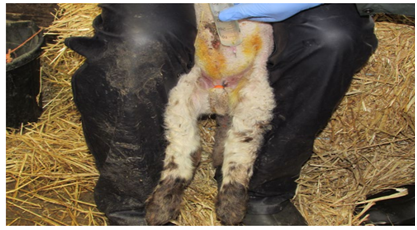Introduction
Goats (Capra hircus) and Sheep (Ovis aries) are an important species of livestock in India, which contribute greatly to the agricultural economy, especially in areas where the crop and dairy farming are not feasible. Goats and sheep provide a dependable source of income to 40% of the rural population below poverty line in India and to many who do not possess any land. Mortality among the pre-weaning animals is one of the major factors causing significant economic losses to the goat and sheep producers. After birth, the kids and lamb face a number of physiological, behavioral and immunological challenges affecting the survival of neonates. Diseases in goats result in mortality which ranges from 5 to 25% in adults and 10 to 40% in kids. Mortality of kids and lambs can be well reduced by proper management, prevention and early identification of diseases.
How the mortality can be reduced?
Through management of ewe and doe- It includes Before breeding, During Gestation, Vaccination and Deworming of kid and lamb
1. Before breeding– Lamb/kid mortality can be reduced by proper reproduction and health management of ewe/doe and ram/buck prior to breeding. First of all, screening should be done in flock and cull the ewe/doe with bad udder or having any other deformity.Record of past performance was also useful to predict future performance. In past performance if ewe and doe having history of poor mothering ability, low milk production or difficulty in lambing and kidding then culling should be done. Give importance to BCS and flushing should always practise before breeding so that it can increased the weaning rate.
2. During gestation– Nutrition should be adequate during gestation so that ewe/doe should having enough body reserve during lambing/kidding and overnutrition is also not recommended because if ewe/doe are too fat then they can face difficulty in parturition.
3. Vaccination and deworming- All ewe and doe should routinely vaccinate against clostridial diseases and ewe/doe should be dewormed 3-4 week before lambing/kidding so that lamb/kid are born into environment with low parasite challenge.
Lambing and kidding management
In lamb and kid most, death occur in neonatal period so proper colostrum feeding should provide at least 10% of body weight. The dam should give birth in a clean environment either in well rotated pasture or stall bedding straw. The location of lambing/kidding stall should be near to well-travelled area so that to see whether parturition is normal or there is any difficulty
Common diseases and their prevention:-
- Hypothermia (Low body temperature)
To prevent hypothermia add equal amount of boiled water to a 40% glucose solution, then allow it to cool to about 390 C and then inject it. Glucose injection should never be given sub cut as this may cause severe irritation.

Warming boxes -Lamb should be laid on a rack or inside a box and warm air is provided from for the fan heater so that temperature inside the box is increased and also there is opening and closing of lid in a box to ensure that lamb does not overheat.
- Watery mouth
Adequate colostrum should be provided. All lamb and kid should receive 50ml/kg/lamb of colostrum or colostrum substitute within 1st hour of life

Figure 3 Prophylactic oral administration of antibiotic drug 
Figure 4 Colostrum supplementation through stomach tube apparatus
- Lamb dysentery
Effective prevention of lamb dysentery is achieved through vaccination of ewes, using a multi component vaccine containing toxoids of Clostridium perfringens type B in an adjuvant.
- Enterotoxigenic Escherichia coli

It depends on strict hygiene, ensuring adequate early colostrum intake and immediate isolation of sick lambs.
- Cryptosporidiosis
Anti-coccidial agents used for the treatment and prevention.

The success of treatment of affected lambs with intensive fluid therapy, broad spectrum systemic antibiotics and NSAIDs is variable.
- Floppy Kid and Drunken Lamb Syndromes

Intravenous administration of sodium bicarbonate solution (65ml of 1.3% solution or 16ml of 5% solution per kg body weight) or oral administration of sodium bicarbonate (0.84g per kg body weight dissolved in 30–100ml water and administered by stomach tube).
Conclusion
The first week of life of lambs and kid is the most critical from the survival point of view. Special care should be given to lambs during the first week of life particularly lambs with low birth weight either born singly or as twins. The nutritional and health status of ewes especially during late gestation and at lambing should be given close and special attention. Farmers should be made to understand the need for lambs and kid to have adequate colostrum immediately after they are lambed (24 -36 hours critical). The management of 1–7-day-old lambs as well as the prompt diagnosis and treatment of neonatal conditions is imperative.
Aditya Chandrakar1 and Nripendra Pratap Singh2
1M.V.Sc Scholar, Livestock Production Management, ICAR-NDRI, Karnal, Haryana
2Ph.D. Scholar, Livestock Production Management, ICAR-NDRI, Karnal, Haryana

